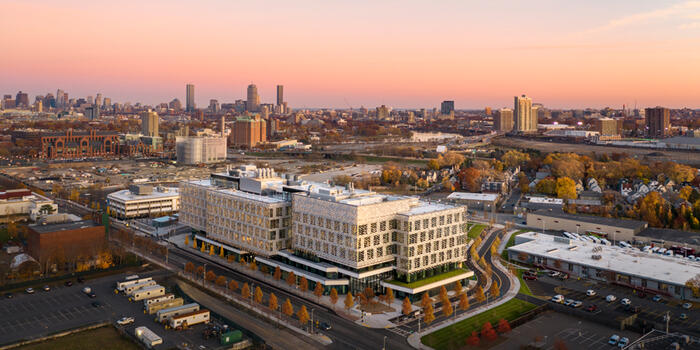Green Good Design Awards Tell a friend
Boston, Massachusetts, USA
Architects: Behnisch Architekten
Landscape Architects: Stephen Stimson Associates Landscape Architects
Structural Engineers: Buro Happold
Climate Engineeris: Transsolar Inc.
Client: Harvard University
Photographers: Brad Feinknopf and Steve Dunwell
The new Science and Engineering Complex, located directly across the Charles River from Harvard’s historic Cambridge campus, is the University’s latest significant addition to its Allston campus.
The cutting-edge laboratory space, generous collaborative environments, and innovative, high-performance façade support the research on visionary projects and the interdisciplinary work.
A landmark design for transformational learning: The eight-level, 544,000-square-foot building is organized into three four-story volumes connected by two glazed, multi-story atria, that provide light-filled social hubs for faculty and students, create linkages and encourage cross-disciplinary work.
Highly visible makerspaces and teaching labs located at street level showcase the exciting work being done at the school. The vibrant public spaces incorporate the structure into the fabric of the neighborhood. The lower floors of the building embrace an extensive landscaped Engineering Yard intended for ceremonial and recreational activities.
Classrooms, teaching labs, and amenity spaces occupy the lower floors and vary in size and layout ranging from typical, theater-style classrooms with sloped floors and fixed seating to flexible spaces that can be reconfigured into flipped classrooms.
Diversity in research: Wet and dry research labs are located on the upper floors, where they provide researchers with more solitude. Modular, flexible laboratory environments, smart zoning of highly ventilated zones from dry space, and centralized lab services ensure future adaptability.
The layered design of the façade calibrates the scale of the large volumes, creates an identity, and plays a crucial role in efficient energy performance.
Sustainability and performance are high priorities for Harvard; the SEC has received LEED Platinum and Living Building Challenge Petal certification in Materials, Beauty, and Equity.
Unprecedented for a building of this size, the LBC Materials Petal attests that the building has been constructed with healthier materials.
In addition to innovative heating and cooling systems, daylighting, and vegetated roofs, the integrated energy concept emphasis on facade design, natural ventilation, and laboratory ventilation.
The world’s first hydroformed stainless-steel screen that wraps the laboratory volumes is precisely dimensioned to shield the interior from solar heat gain during warmer months while admitting beneficial sun during the winter, reducing cooling and heating loads. The screen reflects daylight towards the interior while maintaining large view apertures.
Glazed façade sections feature exterior sunshades and operable windows. The SEC’s highly functional design will strengthen Harvard’s position as a leader at the intersection of engineering and science, setting new standards for high-quality learning environments with rigorous sustainability goals.




















